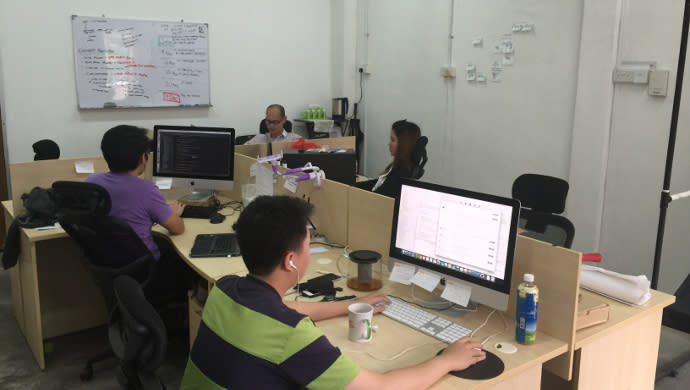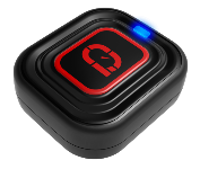By staying lean and focussed, QLIPP may be poised for a grand slam
Donny Soh, Founder of the Singapore-based startup, is confident that his tennis performance IoT wearable sensor will be a big hit. Here’s why
Donny Soh, Founder of QLIPP, with a tennis racket and a QLIPP device attached to it
If you ever feel that your corporate office is too drab; lacking in variety in the potted plant and motivational poster ornaments department, step into QLIPP‘s Singapore office. Not only does it look like a minimalist’s wet dream, it is also the size of a shoebox apartment. But great ideas don’t need to be incubated in a sprawling laboratory or an ostentatious office complex — they need only a leader and a team resolute to see it come to life.
QLIPP is a fine example of that. It has a skeleton crew of five, and a Founder dead set on pursuing his goals and pushing ahead with innovation. From the humble little office tucked away in an industrial estate in Bukit Merah, this tech startup has spread its reach to countries across the globe — from the US to European countries including Germany and Italy.

QLIPP’s spartan office; where dreams take flight
All great ideas have great lessons that can be gleaned from it, so we, at e27, catch up with Donny Soh, Founder of QLIPP, who shares candidly with us, the company’s raison d’etre and merits, the lessons he has learnt, as well as his near- and long-term goals for the device.
Beginnings
“The idea of the tennis performance sensor QLIPP came to me in 2012 when I was still working in A*STAR (Agency for Science Technology and Research, a government-funded R&D facility). I was helping to develop part of the technology there. Although I felt that the wearable IoT (Internet of Things) space possessed big potential to be commercialised, the industry wasn’t that hot yet and not many people were convinced by it,” Soh says.
Also Read: 4 snooze-tracking IoT devices you have to fund now
The wearable IoT device, QLIPP, attaches to the strings of a tennis racket and syncs with a smartphone app to measure your tennis playing performance.
Soh, who has a Master’s degree from the NUS-MIT alliance, as well as a PhD from Imperial College, is an expert in data mining: a skill well-suited to tackle the complex IoT space.
“The barrier entry for entering the wearable tech space is not low. It is a very unique space because it encompasses both the hardware and an app, resulting in the need for a lot of data analysis. It is very difficult to get it right; there are so many moving parts that affect one another,” he says.
While wearable technology isn’t exactly a nascent sector; it is still largely untapped. It first sprung into the commercial world starting with the calculator watch in the 1980s. Since then, the industry has produced mostly rudimentary or gimmicky products such as smart fashion accessories. The challenge here is to provide critical, meaningful information to the wearer in a way that he or she would find it indispensable to their activities or work.
Although A*STAR provided Soh with the apparatus and resources to develop the technology, he felt that the environment was, perhaps, not the best fit for his vision.
“I felt that if I was at A*STAR, I would not have the same hunger. It is a good environment [for innovation] but I felt too comfortable. I had to seize the opportunity when I had little commitments such as having to raise a family,” says Soh.
Also Read: 4 issues that will arise as the IoT space matures
“When I left A*STAR, I was free to pursue this passion with a greater intensity and build it to the level I want,” he adds.
Thus began QLIPP’s journey.
Why focus on tennis?
Before zeroing in on the tennis market, QLIPP was exploring different options in the sports industry.
“We looked at golf but there were already many similar products, and we weren’t confident of making an impact there. For running, the incumbents were strong. For tennis [at that time], there was only one player, it was a nascent area,” says Soh.
In addition, Soh believed that building an MVP (minimum viable product) in the right market was crucial to fast commercialisation.
“We also decided that because of our small team size, it would be best to focus on one sport. One that we believed would allow us to capture a sizeable market share,” says Soh.
Couldn’t QLIPP extend its capabilities to include other racket sports such as badminton and squash though? Why only tennis?
Soh believes that while these sports may share a commonality, they also differ in some ways.
“The QLIPP device is like a data dump, there’s no processing involved. All the processing is done on the app. The app essentially measures the tennis strokes. You could say that it could be used to measure squash strokes as well. The question here is what can this data provide for the user? Assessing tennis strokes is critical to the player but for squash, it is really more about the positioning of your body,” he says.

QLIPP’s testing area
That is not to say that QLIPP will be neglecting the squash market altogether. Soh has plans to enhance the video capabilities of the QLIPP app and tailor it for the squash variation, making it able to record and analyse the player’s movement on the court.
Holding its own against competitors
While QLIPP may have been one of the first to harness wearable technology to enhance the game of tennis, many other products have sprung up as the wearable IoT scene gains momentum.
Soh is not concerned about being overshadowed by many of them, though, and believes that QLIPP’s design makes it superior. Some other products are not so straightforward, he says, while others can only be mounted on tennis rackets, limiting their usage to only one form of sport.
There are serious contenders, however. Soh mentions two – Babolat and Zepp, but he is still confident that his sensor can best them in usability.
Also Read: NeonRunner sprints away with ASEAN Startup of the Year award
“I think the QLIPP sensor can fare better than the Babolat Pop in terms of accuracy, because their unit is attached to the wrist, and that causes a lot of data [in a tennis swing] to be lost. For example, it would not be able to record arm movement. But if you put it on a racket, every degree of movement in your arm is captured, therefore QLIPP’s margin of error is a lot smaller,” says Soh.
This leaves the Zepp sensor, which attaches itself to the base of the racket.
“Zepp’s product is big and when it is fitted onto the base of the racket, it affects the player’s grip. Ours enhances the racket in a more natural way. Tennis players are already used to putting a dampener on the racket strings to make it ‘head-heavier’, allowing them to hit with more power,” he says.
Accelerating its reach
Although QLIPP is choosing to stay lean, it’s not relying on just bootstrapping.
It has partnered with NTUitive, the enterprise and innovation arm of NTU. Through this collaboration, QLIPP was able to accelerate its R&D efforts through the iJAM grants from MDA that was administered by NTUitive. It also helped QLIPP to raise awareness and expand its marketing outreach to trade shows overseas. Through NTUitive, the QLIPP team was also able to head to Silicon Valley to promote the device.

The QLIPP device
Soh’s spot-on foresightedness has started to reap dividends. Not only has QLIPP raised a whooping US$70, 324 in its Indiegogo campaign, which is 150 per cent of its goal, it has also received several nominations and awards.
One of these include the recent Rice Bowl ASEAN awards, in which it emerged at the top in the product category. It also won the German Good Design Award 2016.
While receiving accolades and a healthy cash influx gives a boost to companies, it can only take them so far before they burn through their funds and fame. If longevity is the name of the game, long-term partnerships with other key players in the market is vital to planting a stakehold.
To achieve this, QLIPP has signed a partnership deal with Registro Profesional de Tennis (RPT), a leading global tennis coach association with over 20,000 coaches. QLIPP says it will be providing RPT’s coaches and players with its device. RPT will also have access to QLIPP’s newest technologies from the R&D stage onwards and provide consulting services to publish RPT-related material online.
Also Read: 20 fascinating Asian startups you should know about
In addition, the press release states that they will be “carrying out joint marketing activities of mutual brands to help ensure that players will be exposed to the newest and latest technological equipment. They will work together on developing new tennis communities, which can be used to book RPT coaches or locate hitting partners. These new communities help generate country leaderboards which can be used to identify rising tennis stars.”
Locally, QLIPP has signed up with the Junior Team Tennis League (JTTL) to be a sponsor. It is also looking to partner with the Singapore Tennis Association (STA), although no formal talks have been held yet.
In addition, Soh says that it has distribution channels to shops at Wimbledon and is speaking to several tennis racket manufacturers to potentially piggyback on their products.
Final reflections
While Soh is more than qualified to tackle the wearable tech space, he is still a first-time entrepreneur and has made a few missteps along the way.
“My tip for entrepreneurs is – you have to get the market right. Coming from a technical background, I focussed too much on the product and team and failed to look into the market size. If I had analysed the market sooner, my progress would have been a lot faster,” says Soh.
Soh also fears the possibility of his technology being rendered obsolete.
“Technology leapfrogging what we have now, that is my biggest concern. Consider the Babolat wrist sensor. A smart watch can easily do what it does through an app. Fortunately, we are protected against this for now because our sensor is fitted on the racket. But imagine if we can create smart plastic strips that can gather all sorts of information, and embed it into the rackets, that would be worrying for us,” says Soh.
QLIPP would be implementing greater integration with the Apple Watch in the future, building more interactive visuals and social features such as a ranking system.
Soh says that he is planning a seed round to raise funds for expansion and marketing efforts.
“I’m not an aggressive marketing person or hustler. At the end of the day, I just want to build a product that people will use and impact their lives,” he concludes.
Also Read: 10 cool startups that caught our eye at MaGIC’s inaugural demo day
The post By staying lean and focussed, QLIPP may be poised for a grand slam appeared first on e27.


